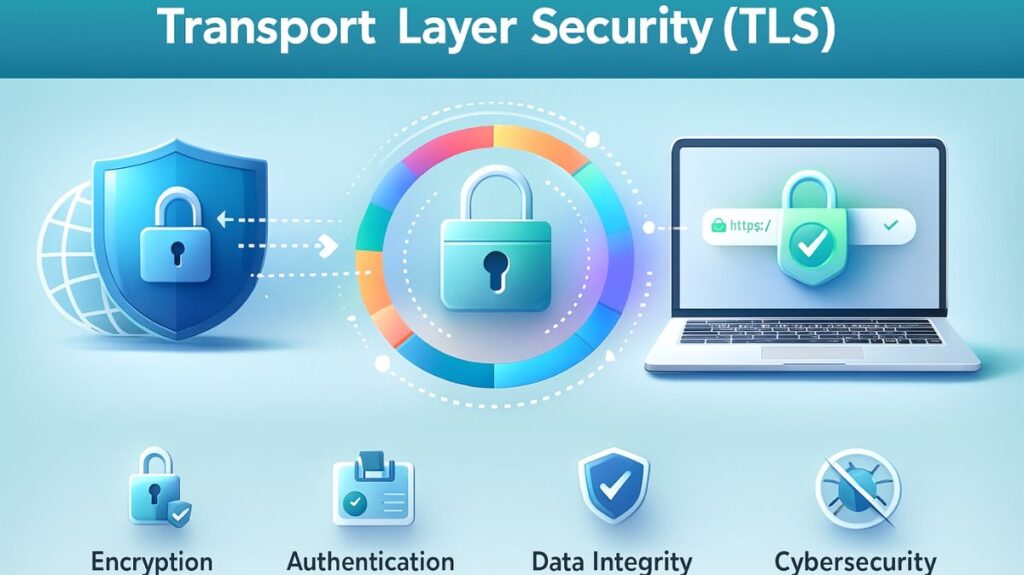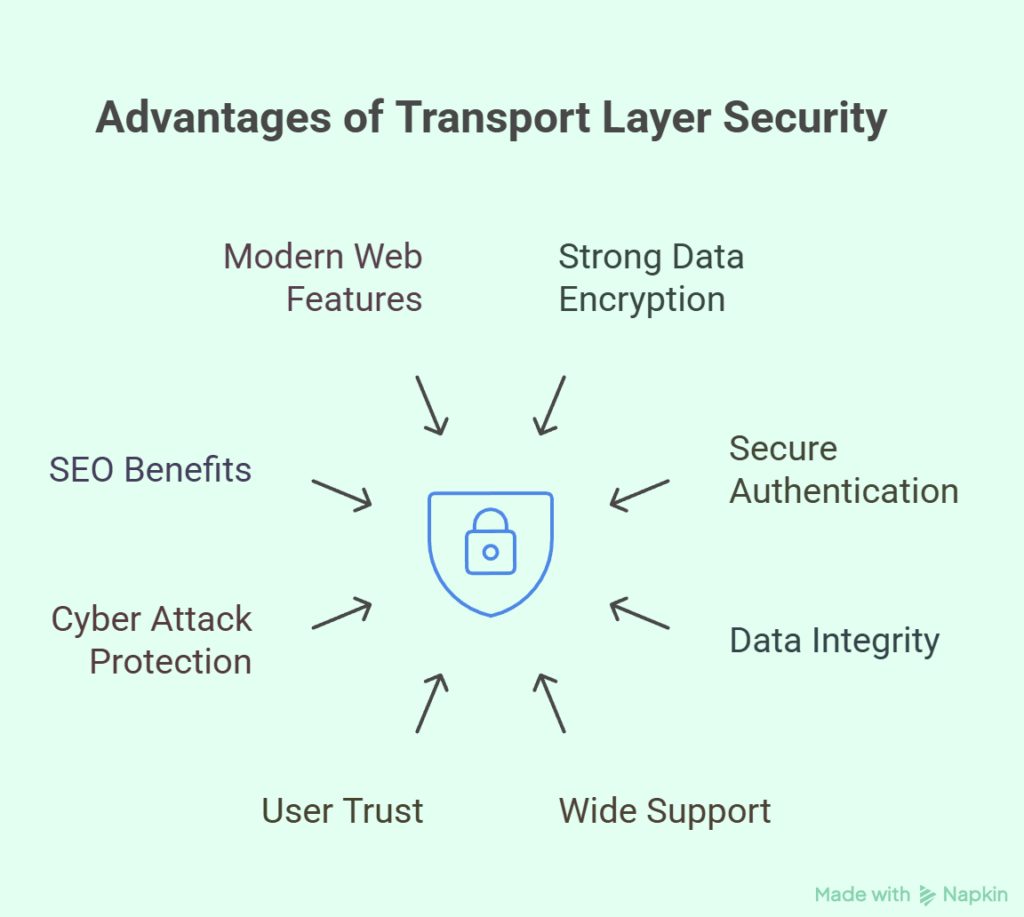Transport Layer Security (TLS), Core Services Offered by TLS, History and Development (SSL vs. TLS), How TLS works: The Handshake, Architecture, and Features, TLS 1.3 Enhancements, Applications, and Adoption, and advantges of transport layer security are some of the subjects we discussed in this blog.
Transport Layer Security (TLS)

A cryptographic protocol called Transport Layer Security (TLS) was created to offer communications over a computer network, such the Internet, security at the transport layer. It is regarded as a key piece of technology for communications security.
TLS’s main objective is to make it possible for two networked devices or applications to securely and privately exchange data while prohibiting unauthorized parties from listening in on or altering messages sent back and forth between a client and a server.
Also Read About What Is A WPA2 PSK Key? And How Does WPA2 PSK Work?
Core Services Provided by TLS
By guaranteeing the three essential characteristics of a secure channel authentication, confidentiality (encryption), and integrity TLS secures communications.
Encryption (Confidentiality): TLS employs encryption to conceal the data being sent, guaranteeing that private data (such as credit card numbers or passwords) is kept private and unreadable by unauthorised parties while in transit.
Authentication: This service verifies the identity of the persons involved in communication. The client can choose not to authenticate, but the server must. Digital certificates, also known as TLS/SSL certificates, issued by a reliable Certificate Authority (CA) are commonly used to confirm the identification of servers.
Integrity: Between encryption and decryption, TLS confirms that the data has not been changed, corrupted, tampered with, or fabricated. A message integrity check with a message authentication code (MAC) is frequently used to guarantee this.
History and Evolution (SSL vs. TLS)
Secure Sockets Layer (SSL), a security protocol created by Netscape Communications, was the ancestor of TLS.
- The official renaming of the protocol occurred in 1999 when the Internet Engineering Task Force (IETF) specified TLS 1.0 (RFC 2246) as an update to SSL 3.0.
- The phrase “SSL certificate” is still frequently used in the industry to refer to a TLS certificate, despite SSL being antiquated, insecure, and all versions (1.0, 2.0, and 3.0) being decommissioned and deprecated.
- TLS keeps changing to meet emerging security risks. Formally, TLS 1.0 and 1.1 are no longer supported. TLS 1.3 (RFC 8446), which was specified in August 2018, is the most recent version.
How TLS Works: The Handshake
The TLS handshake protocol, a critical stage in which the client (such as a web browser) and the server agree the parameters for secure communication, is where a secure connection utilizing TLS starts.
TLS employs a hybrid cryptography strategy:
- During the handshake phase, asymmetric cryptography (public/private keys) is utilised to safely create a shared secret key.
- Symmetric Cryptography (Shared Key/Session Key): The connection transitions to the quicker symmetric encryption for the majority of the data flow after the shared secret has been established.
Also Read About What Is WPA Shared Key? Advantages of Shared key In Network
Key Steps in a Handshake (Simplified):
Client Hello: The procedure is started by the client, which sends a random string of bytes, a list of supported cypher suites (encryption techniques), and the highest version of the TLS protocol it supports.
Server Hello & Certificate: In response, the server chooses the best TLS version and cypher set. The client can then confirm the server’s legitimacy by requesting its digital certificate, which includes the server’s public key and identifying details.
Key Exchange: To safely create a shared secret keying material (the session key or master secret) over the untrusted network, a key exchange mechanism is utilized, such as Diffie-Hellman Key Exchange or RSA, depending on the cypher suite.
Finished Messages: After exchanging a ChangeCipherSpec record, both parties send encrypted Finished messages to indicate that they have correctly deduced the session key and are prepared for secure communication.
Application Data: Using the predetermined session keys, all application data transfers are symmetrically encrypted when the handshake is finished.
Architecture and Features
There are two sub-protocols of the TLS protocol:
- The TLS Handshake Protocol authenticates the parties and sets the parameters for a secure connection.
- Using the keys and algorithms agreed upon during the handshake, the TLS Record Protocol is in charge of protecting the data sent across the connection in order to guarantee confidentiality, integrity, and authenticity.
Key Security Features:
- Cypher Suites: These are collections of cryptographic algorithms that control data encryption, key agreement, and authentication and are selected during the handshake. TLS makes use of both symmetric (like AES) and asymmetric (like RSA and Diffie-Hellman) methods.
- PFS (perfect forward secrecy) and FS (forward secrecy): Because ephemeral (temporary, single-use) session keys were created for each session and never saved, this crucial feature guarantees that previous conversations cannot be decrypted in the event that an attacker compromises the server’s long-term private key in the future. Forward-secure modes must be used, according to TLS 1.3.
TLS 1.3 Improvements
TLS 1.3, the most recent version, has several enhancements that boost security and efficiency:
Faster Handshake: In most situations, the handshake is completed in a single round trip, which lowers latency. It can enable a 0-RTT (zero round trip time) handshake for repeat customers, which can result in notable speed improvements.
Enhanced Security: It eliminates TLS 1.2’s unnecessary, risky, and out-of-date features, including renegotiation, compression, and weak cryptographic hash algorithms like MD5 and SHA-224.
Mandated PFS: Perfect forward secrecy is required by TLS 1.3.
Enhanced Privacy: The TLS 1.3 handshake is encrypted, which encrypts the client and server certificates (but not the client’s server identity).
Also Read About Wireless Local Area Network WLAN Creation and Components
Applications and Adoption
TLS is extensively used to secure different kinds of digital communication, including:
- HTTPS: Hypertext Transfer Protocol Secure (HTTPS), which protects online traffic between a website and a web browser, is built on top of TLS. Port 443 is typically used for HTTPS traffic.
- SMTPS, POP3S, and IMAPS are mail protocols that use email security.
- Voice over IP (VoIP) conversations, instant messaging, and virtual private networks (VPNs) are all secured with it.
Advantges Of Transport Layer Security

Strong Data Encryption
Data transmitted across a network is encrypted by TLS, making it impossible for anyone to read or decipher even if they manage to intercept it.
Secure Authentication
TLS uses digital certificates to verify the legitimacy of the server (and optionally the client). This reduces phishing and spoofing by stopping attackers from impersonating a reliable website.
Data Integrity
TLS guards against data corruption or alteration while it’s being transmitted. TLS recognises attempts to alter the data.
Widely Supported and Trusted
Every major web browser, email service, application, and server supports TLS. For safe online communication, it is the industry standard.
Helps Build User Trust
TLS-enabled websites display HTTPS and a padlock icon in the browser. This boosts user confidence, particularly when it comes to banking, online shopping, and disclosing personal information.
Protection Against Cyber Attacks
TLS aids in defence against:
- Man-in-the-middle attacks
- Eavesdropping
- Session hijacking
- Replay attacks
SEO Benefits
Website visibility can be enhanced by ranking HTTPS websites higher than non-secure (HTTP) websites in search engines like Google.
Enables Secure Use of Modern Web Features
TLS is required for technologies like:
- HTTP/2 and HTTP/3 (faster internet browsing)
- Secure cookies
- Web apps and APIs
Also Read About Man In The Middle MitM Phishing Attacks And How It Works?
